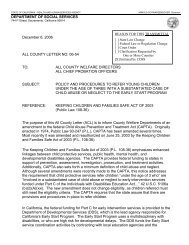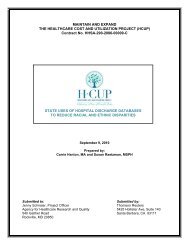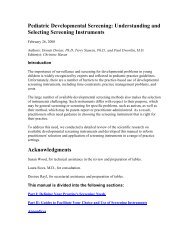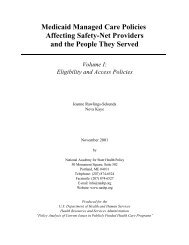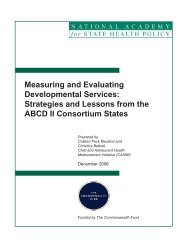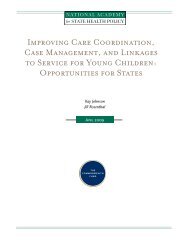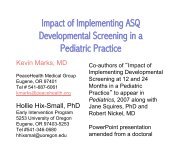Developing Federally Qualified Health Centers into Community ...
Developing Federally Qualified Health Centers into Community ...
Developing Federally Qualified Health Centers into Community ...
Create successful ePaper yourself
Turn your PDF publications into a flip-book with our unique Google optimized e-Paper software.
complement of health care and support services; providers through the National <strong>Health</strong><br />
Services Corps; and eligibility to apply for government-sponsored malpractice coverage.<br />
FQHCs also have expertise in providing comprehensive medical homes to vulnerable<br />
populations, including linkages to health and social services. In addition to helping<br />
private practices, FQHCs may find that by entering <strong>into</strong> collaborative relationships with<br />
states and private practices, they strengthen their own financial position, advance their<br />
quality goals, improve their staffing mix, enhance the continuum of care and the kinds of<br />
services available to their patients, and further their mission.<br />
The Affordable Care Act provides resources that may help states develop a better<br />
primary care infrastructure for Medicaid populations. These include significant federal<br />
funding for health center operational and infrastructure expansion, along with additional<br />
funding to improve primary care practice delivery. 4<br />
The inspiration for this report came from Montana Medicaid’s <strong>Health</strong><br />
Improvement Program. Conceived by the state Medicaid agency, the program has<br />
entailed shifting an existing budget for disease management from an out-of-state vendor<br />
to FQHCs across the state. FQHC-based staff members provide care management<br />
services for Medicaid beneficiaries, including those who do not receive their primary care<br />
from the FQHC. The state has developed ―what’s on hand‖ <strong>into</strong> a community resource or<br />
―shared utility‖ of services that may improve care delivery for all Medicaid beneficiaries,<br />
as well as reduce state costs. This model may have broad appeal for other states.<br />
With support from The Commonwealth Fund, the National Academy for State<br />
<strong>Health</strong> Policy (NASHP) sought to identify other examples of state and FQHC<br />
collaborations that involve sharing services among practices to improve the delivery of<br />
comprehensive primary care. To do so, we interviewed a number of federal and national<br />
experts, scanned the literature, and surveyed state Primary Care Associations. Although<br />
there is increasing interest in developing resources to help small and medium-sized<br />
practices become medical homes, we did not find many models that involved state and<br />
FQHC collaboration. 5 According to those we interviewed, there may be several reasons<br />
for this: 1) state officials and FQHCs may not be aware of the potential for FQHCs to use<br />
their resources for activities and services provided outside of the four walls of their<br />
facilities; 2) the collaborative model may not be appropriate in certain types of<br />
communities or delivery systems; and 3) the inspiration and leadership needed to deploy<br />
such an innovative model may not be present.<br />
2



